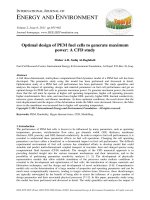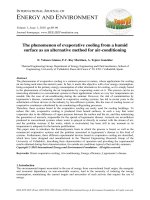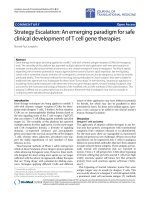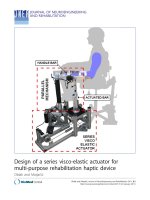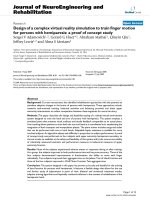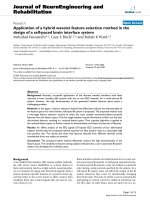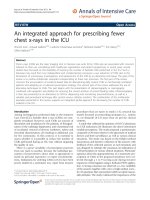An integrated method for multi-objective optimal design of a piped irrigation network
Bạn đang xem bản rút gọn của tài liệu. Xem và tải ngay bản đầy đủ của tài liệu tại đây (441.6 KB, 8 trang )
����������������������������������������������������������������������������������������������������������������������������������������������������������������������������������������������������������������������������������������������������������������������������������������������������������������������������������������������������������������������������������������������������������������������������������������������������������������������������������������������������������������������������������������������������������������������������������������������������������������������������������������������������������������������������������������������������������������������������������������������������������������������������������������������������������������������������������������������������������������������������������������������������������������������������������������������������������������������������������������������������������������������������������������������������������������������������������������������������������������������������������������������������������������������������������������������������������������������������������������������������������������������������������������������������������������������������������������������������������������������������������������������������������������������������������������������������������������������������������������������������������������������������������������������������������������������������������������������������������������������������������������������������������������������������������������������������������������������������������������������������������������������������������������������������������������������������������������������������������������������������������������������������������������������������������������������������������������������������������������������������������������������������������������������������������������������������������������������������������������������������������������������������������������������������������������������������������������������������������������������������������������������������������������������������������������������������������������������������������������������������������������������������������������������������������������������������������������������������������������������������������������������������������������������������������������������������������������������������������������������������������������������������������������������������������������������������������������������������������������������������������������������������������������������������������������������������������������������������������������������������������������������������������������������������������������������������������������������������������������������������������������������������������������������������������������������������������������������������������������������������������������������������������������������������������������������������������������������������������������������������������������������������������������������������������������������������������������������������������������������������������������������������������������������������������������������������������������������������������������������������������������������������������������������������������������������������������������������������������������������������������������������������������������������������������������������������������������������������������������������������������������������������������������������������������������������������������������������������������������������������������������������������������������������������������������������������������������������������������������������������������������������������������������������������������������������������������������������������������������������������������������������������������������������������������������������������������������������������������������������������������������zation model of piped
irrigation network design was developed to
simultaneously achieve the minimum cost of
construction and the maximum service life
based on selecting different available dimeters
and material for pipe segments. Secondly,
NSGA ii was used to find sets of non-dominated
optimal solutions and subsequently define the
set of Pareto – optimal solutions. Finally, one of
Pareto – optimal solutions was recommended to
decision makers for implementation by using
several selection methods.
2.1. Optimal Model of Piped Irrigation
Network Design
2.1.1. Objective functions
The first objective is to minimize the cost of
pipe. Here, the pipe cost (Cp) includes the pipe
construction cost (Cc) and the operational cost
(Co). The pipe cost depends on diameters,
material, construction method, working hours of
pipes, discharges.
Min Cp = Cc+ Co
(2.1)
The construction cost (Cc) includes the cost
of pipe material (Cm) at site and the cost of
laying (CL).
Cc = Cm +CL
10
(2.2)
According to Hai (2018) and Lin et al.
(2016), Cm and CL were defined as follows.
Cm=
(2.3)
CL=
(2.4)
Where:
Di is the pipe diameter of the ith pipe
segment;
Li is the length of the pipe segment;
Cmo and α are empirical coefficients,
depending on specific material.
n is the total number of pipe segments of
piped irrigation networks
The operational cost (Co) was determined in
the following equation.
Co =
(2.5)
Where:
Qi is the calculated discharge of the ith pipe
segment;
Ti is the working duration corresponding Qi
of the ith pipe segment;
m is the project life, m=30 years;
ki =1 if the ith pipe segments locate along the
disadvantage route and ki = 0 if not.
Hi is the hydraulic loss of the ith pipe
segment which is calculated by Hazen Williams
formula as follows:
Hi =
(2.6)
where:
Ci is the roughness coefficient determined by
pipe material of the ith pipe segment and the
others are explained above.
The second objective is to maximize the
service life of piped irrigation network. Here,
the service life of piped irrigation network is
defined as the average service life of all pipe
segments.
Maximize SL =
(2.7)
Journal of Water Resources & Environmental Engineering - No. 82 (12/2022)
Where: SLi is the service life of the ith pipe
segment
2.1.2. Constraints
Velocity of the pipe ith segment (Vi) is in the
allowable range: 0.3 m/s ≤ Vi ≤ 3 m/s (2.8)
Along the main pipeline, diameters of the
upstream pipe segments (Dup) are not smaller
than that of the downstream pipe segments
(Ddow): Dup ≥ Ddow
(2.8)
2.1.3. Decision variables
The decision variables are the pipe diameter
(Di), the pipe material (Mi) and the length of
pipe segment (Li).
2.2. NSGA-II
The NSGA-II algorithm (Deb et al. 2002) is
used to find the set of Pareto optimal solutions
for multi-objective optimization problems. The
three main features of the NSGA-II algorithm
are: developing elites, using a mechanism to
preserve the diversity of solutions, and focusing
on non-domination solutions. In this paper, the
MOO problem was formulated in MS Excel,
subsequently solved by MOO program
developed by Sharma et al. (2012).
Table1. Encoding rule for available diameters
and material
Diameter (mm)
No. Encode
1
2
3
4
PVC
HDPE
MSP
DIP
1
1
63
32
50
50
2
2
75
63
65
60
3
3
90
90
80
65
4
4
110
110
100
80
5
5
125
125
125
125
6
6
140
160
150
150
7
7
160
180
200
200
8
8
180
225
250
250
9
9
200
250
300
300
10
10
225
280
350
350
11
11
250
315
400
400
12
12
280
355
450
450
13
13
315
500
500
500
Diameter (mm)
No. Encode
1
2
3
4
PVC
HDPE
MSP
DIP
14
14
355
520
520
600
15
15
400
600
600
700
16
16
450
700
700
800
17
17
500
800
800
900
Note: PVC is Poly-Vinyl Chloride; HDPE is High
Density Polyethylene Pipe; MSP is Mild Steel Pipe;
DIP is Ductile Iron Pipe.
2.2.1. Selection Methods for Pareto-Optimal
Solutions
First, all Pareto-optimal solutions of MOO
problem which were generated by using NSGA
II several times were combined. Subsequently,
the set of Pareto-optimal solutions were sorted
in non-domination principle, consequently
finding the true Pareto-optimal front. Finally,
combinations of the entropy weighting method
against TOPSIS selection methods were utilized
to recommend one optimal solution for the
decision makers. The entropy method is based
on a measure of uncertainty in information,
formulated in terms of probability theory ( Li; et
al. 2014). The TOPSIS selected optimal solution
has the smallest Euclidean distance from the
positive ideal solution (PIS) and the largest
Euclidean distance from the negative ideal
solution (NIS). The PIS is comprised of the best
value of each objective in the given optimal
solutions, while the NIS is a combination of the
worst value of each objective in the given
optimal solutions (Hwang and Yoon 1981).
Here, TOPSIS selection method were solved by
using MS Excel program developed by Wang et
al. (2020).
2.2.2. Study Case of Water Supply Pipe
Network
The study area is located at Tho Xuan
District, Thanh Hoa province, Vietnam. The
study area is 162 hectares which apply modern
agriculture practices to various crops including
Journal of Water Resources & Environmental Engineering - No. 82 (12/2022)
11
tea, dragon fruit, sugarcane, oranges and
pomelo. The average annual rainfall of the area
is 1911 m. The climate is divided into two
distinct seasons: rainfall season from May to
October and dry season from November to May.
The average humidity of the area is 86%. The
land in the study area is mainly low hills. The
piped irrigation system is designed to pump
water from Chu river to the modern agricultural
area and Lam Son Sugar Factory (Figure 1). The
piped irrigation system consists of 30 pipe
segments including 15 main pipe segments and
15 branched pipe segments. Material of each
pipe segment could be one of PVC, HDPE,
MSP and DIP. The parameters of each material
are shown in Table 2.
Figure 1. Calculation diagram of the piped irrigation system
Table 2. Parameters of pipe materials
No.
1
2
3
Material
Parameters
Cmo
C
PVC
HDPE
MSP
DIP
285.3
0.0034
140
233
0.0059
150
287
0.0076
130
476
0.0044
120
Note: Cmo and are empirical coefficients which are extracted by a regressive analysis for each material;
C is pipe roughness coefficient.
The calculated flow of each pipe segment
is calculated based on the service area and
the irrigation coefficient of each crop.
Irrigation coefficient, the amount of
irrigation water and irrigation duration of
each crop are referred to in the Irrigation
Manual for Dry Crops (MARD 2013).
Calculation results of flow rate and irrigation
duration for pipe segments are shown in
Tables 3 and 4.
Table 3. Flow rate and irrigation duration of branch pipes
12
No.
Branch
pipe
Areas
(ha)
1
2
3
4
5
6
7
8
9
16
17
18
19
20
21
22
23
24
19.3
25.7
11.1
16.0
13.5
13.1
13.0
15.8
5.6
Irrigation
rates
(l/s.ha)
2.47
2.55
4.17
3.01
2.55
3.01
2.47
3.01
2.55
Discharges
(m3/s)
Crops
Lengths(m)
0.048
0.065
0.046
0.048
0.034
0.039
0.032
0.048
0.014
Dragon fruit
Orange
Tea
Sugar cane
Orange
Sugar cane
Dragon fruit
Sugar cane
Orange
211.3
483.9
209.5
731
247.7
332.2
296.1
334.9
72.4
Irrigation
duration
(h/year)
324
216
192
398
216
398
324
398
216
Journal of Water Resources & Environmental Engineering - No. 82 (12/2022)
No.
Branch
pipe
Areas
(ha)
Irrigation
rates
(l/s.ha)
Discharges
(m3/s)
Crops
Lengths(m)
Irrigation
duration
(h/year)
10
11
12
13
14
15
25
26
27
28
29
30
4.3
6.6
5.1
3.6
5.3
3.5
1.30
1.91
1.30
2.55
2.55
2.55
0.006
0.013
0.007
0.009
0.013
0.009
Factory
Grapefruit
Factory
Orange
Orange
Orange
289.8
320.4
181.5
91.9
81
158.5
1056
216
1056
216
216
216
Table 4. Discharges of main pipes
No.
Main pipe
1
2
3
4
5
6
7
8
9
10
11
12
13
14
15
1
2
3
4
5
6
7
8
9
10
11
12
13
14
15
Area
(ha)
162
142
117
105
89
76
63
50
34
28
24
17
12
9
4
Discharge
(m3/s)
0.43
0.38
0.32
0.27
0.22
0.19
0.15
0.12
0.07
0.06
0.05
0.04
0.03
0.02
0.01
Length
(m)
316.7
125.3
108.2
35.9
110.7
156
99.7
66.7
179.5
65.4
53.1
56
34.2
138.3
25
3. Results and discussion
3.1. Minimization of cost together with maximization of life span
Journal of Water Resources & Environmental Engineering - No. 82 (12/2022)
13
Figure 2. Results of minimization of cost coincident with maximization of life span:
(a)Pareto optimal solutions, (b) Pipe materials of pareto solutions,
(c) Pipe diameters of pareto solutions, and (d) Velocities of pareto solutions
Figure 2a describes the optimal trade-off
solution for two objectives, which are
minimizing the implementation cost and
maximizing the life span of pipes. For each pipe
segment, 17 possible diameter alternatives and
four possible material alternatives were
evaluated. For total 30 pipe segments, the
solution space consists of 430×1730 solutions.
The parameters were set for NSGA II including
300 generations, a crossover rate of 0.9, a
mutation rate of 0.65, and a population size of
600. NSGA II generated from 3 to 8 optimal
solutions for each run. A total of 102 optimal
solutions were combined through 22 run times.
Each optimal solution is a combination of 30
pipe segments with defined diameters and
materials. By using non dominated sorting in
MS Excel for 102 optimal solutions, 11 non
dominated optimal solutions were defined and
plotted in Figure 2a. Figure 2a indicate that the
pipe cost is in the rage of from 11.5 to 32.8 ×109
VND and the corresponding life span is from
43.6 to 67 years. This means that an increase by
23 years in the life span required an additional
investment of 30 ×109 VND. No pipe segments
utilized MSP material due to its high price unit.
DIP utilization (Fig. 2b) is the most popular in
all optimal solutions. The second and third
popularities in material utilization are HDPE
14
and PVC, respectively. Figure 2c indicates that
velocities of all pipe segments of all solutions
strictly followed the constraint, in the rage of
from 0.3 m/s to 3 m/s. The mean velocities of
the pipe segments made of PVC (0.89 m/s) is
lower than those made of HDPE (1.05 m/s) or
DIP (1.37 m/s). Figure 2d shows that the
constraint of diameters along the main pipe
routine is completely satisfied because there is
not an increase in diameters from the upstream
to downstream pipes. These prove that all
constraints were strictly followed when finding
the optimal solutions.
3.2. Selection one of Pareto optimal
solutions
Figure 3. Recommended optimal solutions
selected by TOPSIS selection methods
Journal of Water Resources & Environmental Engineering - No. 82 (12/2022)
To recommend the decision makers to
choose one Pareto-optimal solution for
implementation, TOPSIS selection methods
were utilized. The entropy weighting method
objectively generated two weights of 0.856
and 0.144 which were respectively assigned
for cost and life span objectives of TOPSIS
selection methods. The optimal solution
having cost of 11.5 ×109 VND and life span of
43.6 years was chosen for implementation
because of its most popular recommendation
by 11 selection methods (Figure 3). The
decision variables of the final chosen optimal
solution was shown in Table 5. The results
indicate that the percentage of pipe material
were 27%, 33% and 40% for PVC, HDPE and
DIP, respectively. The velocities of the main
pipes are in the range of 0.8-2.3 m/s which is
narrower than the range of 0.3-2.8 m/s in the
branch pipes.
Table 5. Decision variables of the chosen optimal solution
Velocity
Diameter
Velocity
Diameter
(m/s)
(mm)
(m/s)
(mm)
HDPE
0.8
DIP
1.5
600
17
PVC
2
HDPE
2.0
500
3
18
18
3
DIP
1.6
500
4
200
19
4
DIP
1.4
500
2.8
125
20
5
HDPE
1.1
500
PVC
0.5
315
21
6
DIP
1.0
500
22
PVC
2.1
140
22
7
DIP
0.9
450
8
23
PVC
2.4
160
23
8
DIP
1.2
350
9
24
PVC
1.5
110
24
9
DIP
1.0
300
10
25
PVC
0.5
125
25
10
DIP
1.1
250
11
26
PVC
0.8
140
26
11
HDPE
1.3
225
12
27
HDPE
0.3
160
27
12
HDPE
1.0
225
13
28
PVC
0.4
180
28
13
HDPE
0.8
225
14
29
DIP
1.7
100
29
14
HDPE
2.3
110
15
30
HDPE
0.9
110
30
15
DIP
1.1
100
No.
Pipe
Material
No.
Pipe
Material
1
16
280
16
1
2
0.4
450
17
HDPE
2.3
160
19
DIP
1.5
5
20
DIP
6
21
7
In Vietnam, dendritic pipe networks such as
piped irrigation networks and rural water supply
networks have been designed through selecting
velocity for each pipe segment based on the
range of economical velocities ruled in the
codes without additional specific guidance
(MOC 2006). In fact, economical velocities
depend on material, price of pipes and
consequently the economical velocities change
with various pipe material as well as places to
install pipes. Therefore, referring only the range
of economic velocity in the codes for design of
different dendritic pipe networks could consist
of high uncertainty. The integrated NSGA II
and MCDM method to optimally design
dendritic pipe networks was considered as novel
contribution to fill the gap. In future, various
construction methods of pipe segments should
be included in the proposed method to adapt the
complicated characteristics of topography and
geology.
4. Conclusions
This paper proposed the coupled method of
NSGA II and Multiply Criteria Decision Making
to find one optimal design alternative of piped
irrigation
systems
when
simultaneously
Journal of Water Resources & Environmental Engineering - No. 82 (12/2022)
15
considering two objectives including the
minimum pipe cost and the maximum life span.
Subsequently, the coupled method was applied
on the real piped irrigation system consisting of
30 pipe segments. Each design solution of a pipe
segment included one of 17 available diameter
sizes and one of 4 material types. From 430×1730
possible design solutions of the piped irrigation
system, NSGA II finds 11 Pareto-optimal
solutions. Accordingly, the pipe cost is in the
rage of from 11.5 to 32.8 ×109 VND
corresponding to the life span range varying from
43.6 to 67 years. By using TOPSIS selection
methods, the optimal solution with the pipe cost
of 11.5 ×109 VND and the life span of 43.6 years
was selected based on its most popular
recommendation from 14 selection methods.
The proposed coupled method could be
applied to find optimal design of other piped
irrigation systems. In future, the life span should
be considered as a function of material,
diameter and buried depth.
References
Artina, S., Bragalli, C., Erbacci, G., Marchi, A.,
and Rivi, and M. (2012). “Contribution of
parallel NSGA-II in optimal design of water
distribution
networks.”
Journal
of
Hydroinformatics, 14(2), 310–323.
Deb, K., Pratap, A., Agarwal, S., and Meyarivan,
T. (2002). “A fast and elitist multiobjective
genetic
algorithm:
NSGA-II.”
IEEE
Transactions on Evolutionary Computation,
6(2), 182–197.
Hafezalkotob, A., Hafezalkotob, A., Liao, H., and
Herrera, F. (2019). “An overview of
MULTIMOORA for multi-criteria decisionmaking: Theory , developments , applications ,
and challenges.” Information Fusion, Elsevier
B.V., 51(12), 145–177.
Hai, D. M. (2018). “Multi-Objective Optimal
16
Design Of Sewerage Rehabilitation for the Sam
Son Sewerage System, Thanh Hoa Province.”
Journ of Water Resources and Environmental
Engineering, 63, 49–57.
Hwang, C. L., and Yoon, K. (1981). Multiple
Attribute Decision Making: Methods and
Applications. Springer-Verlag, Berlin.
Li, L., Liu, F., and Li, C. (2014). “Customer
satisfaction evaluation method for customized
product development using Entropy weight and
Analytic Hierarchy Process.” Computers &
Industrial Engineering, 77, 80–87.
Lin, Y.-H., Chen, Y.-P., Yang, M.-D., and Su, T.C. (2016). “Multiobjective Optimal Design of
Sewerage Rehabilitation by Using the
Nondominated Sorting Genetic Algorithm-II.”
Water Resources Management, 30(2), 487–503.
MARD. (2013). Irrigation Manual for Dry Crops.
MOC. (2006). “Water Supply - Distribution
System and Facility Design Standard.”
Parhi, S. S., Rangaiah, G. P., and Jana, A. K.
(2020). “Mixed-Integer Dynamic Optimization
of Conventional and Vapor Recompressed
Batch Distillation for Economic and
Environmental
Objectives.”
Chemical
Engineering Research and Design, Institution
of Chemical Engineers, 154, 70–85.
Sharma, S., Rangaiah, G. P., and Cheah, K. S.
(2012). “Multi-objective optimization using MS
Excel with an application to design of a
falling-film evaporator system.” Food and
Bioproducts
Processing,
Institution
of
Chemical Engineers, 90(2), 123–134.
Wang, Z., Parhi, S. S., Rangaiah, G. P., and Jana,
A. K. (2020). “Analysis of Weighting and
Selection Methods
for
Pareto-Optimal
Solutions of Multiobjective Optimization in
Chemical Engineering Applications.” Ind. Eng.
Chem. Res., 59(33), 14850–14867.
Zhao, H., and Li, R. (2020). “Low-pressure
pipeline irrigation technology in China.”
Irrigation and Drainage, 69(S2), 41–47.
Journal of Water Resources & Environmental Engineering - No. 82 (12/2022)

